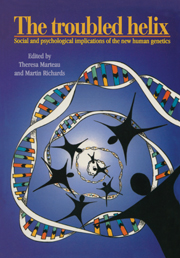Book contents
- Frontmatter
- Contents
- List of contributors
- Preface
- Preface to the paperback edition
- Acknowledgements
- Part I Personal stories
- Part II Clinical context
- Part III Social context
- 9 The troubled helix: legal aspects of the new genetics
- 10 Human pedigree and the ‘best stock’: from eugenics to genetics?
- 11 Public understanding of the new genetics
- 12 Families, kinship and genetics
- 13 Ethics of human genome analysis: some virtues and vices
- 14 Genetics and racism
- 15 Predictive genetics: the cultural implications of supplying probable futures
- 16 The new genetics: a feminist view
- 17 Afterword
- Index
11 - Public understanding of the new genetics
from Part III - Social context
Published online by Cambridge University Press: 01 June 2011
- Frontmatter
- Contents
- List of contributors
- Preface
- Preface to the paperback edition
- Acknowledgements
- Part I Personal stories
- Part II Clinical context
- Part III Social context
- 9 The troubled helix: legal aspects of the new genetics
- 10 Human pedigree and the ‘best stock’: from eugenics to genetics?
- 11 Public understanding of the new genetics
- 12 Families, kinship and genetics
- 13 Ethics of human genome analysis: some virtues and vices
- 14 Genetics and racism
- 15 Predictive genetics: the cultural implications of supplying probable futures
- 16 The new genetics: a feminist view
- 17 Afterword
- Index
Summary
Introduction
In recent years there has been growing concern about the public understanding of science throughout the industrialised world. Such concern has fostered a wide range of practical initiatives aimed at promoting greater public understanding of science on the part of governments, scientific institutions, science-based industries and the mass media (for an international review, see Schiele et al. (1994)); at the same time it has facilitated the growth of research concerned with the interrelations between science and the public. In the UK, for example, a scientific inquiry into the public understanding of science (Royal Society, 1985) stimulated the Royal Society to join forces with the British Association for the Advancement of Science and the Royal Institution of Great Britain in the establishment of the Committee for the Public Understanding of Science (COPUS), and it provoked the Economic and Social Research Council to establish a substantial research programme in this area (Wynne, 1991; Ziman, 1991).
Within the broad field of the public understanding of science, medical science occupies a very special position. For obvious reasons, research on health and illness is of great relevance to everyone. Research reveals a substantially higher level of public interest in medical science than in other branches of science and technology (Durant et al., 1989), and this is reflected in the fact that the mass media consistently allocate more space and time to medical science than to other sciences (Hansen and Dickinson, 1992).
- Type
- Chapter
- Information
- The Troubled HelixSocial and Psychological Implications of the New Human Genetics, pp. 235 - 248Publisher: Cambridge University PressPrint publication year: 1996
- 39
- Cited by

